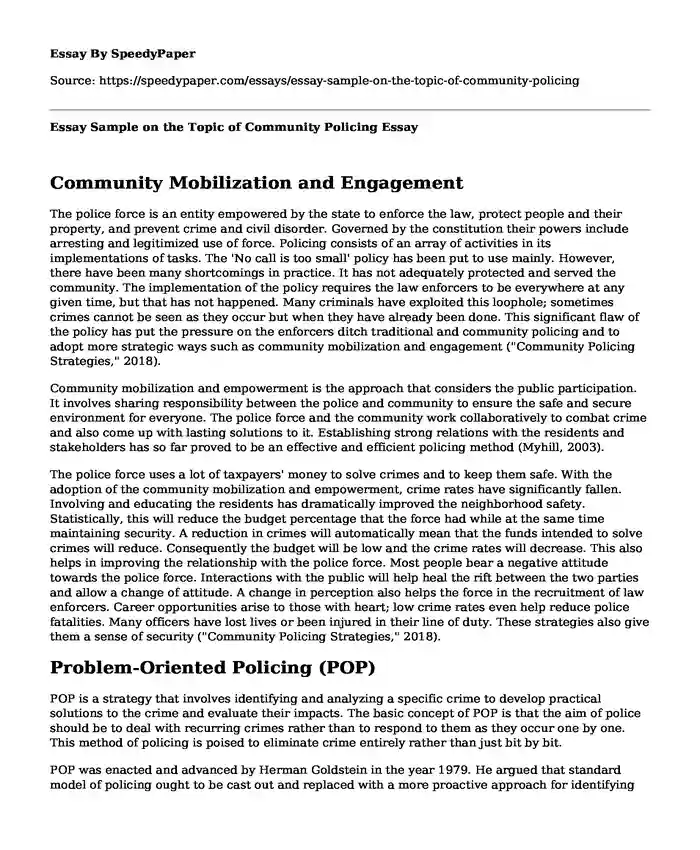Community Mobilization and Engagement
The police force is an entity empowered by the state to enforce the law, protect people and their property, and prevent crime and civil disorder. Governed by the constitution their powers include arresting and legitimized use of force. Policing consists of an array of activities in its implementations of tasks. The 'No call is too small' policy has been put to use mainly. However, there have been many shortcomings in practice. It has not adequately protected and served the community. The implementation of the policy requires the law enforcers to be everywhere at any given time, but that has not happened. Many criminals have exploited this loophole; sometimes crimes cannot be seen as they occur but when they have already been done. This significant flaw of the policy has put the pressure on the enforcers ditch traditional and community policing and to adopt more strategic ways such as community mobilization and engagement ("Community Policing Strategies," 2018).
Community mobilization and empowerment is the approach that considers the public participation. It involves sharing responsibility between the police and community to ensure the safe and secure environment for everyone. The police force and the community work collaboratively to combat crime and also come up with lasting solutions to it. Establishing strong relations with the residents and stakeholders has so far proved to be an effective and efficient policing method (Myhill, 2003).
The police force uses a lot of taxpayers' money to solve crimes and to keep them safe. With the adoption of the community mobilization and empowerment, crime rates have significantly fallen. Involving and educating the residents has dramatically improved the neighborhood safety. Statistically, this will reduce the budget percentage that the force had while at the same time maintaining security. A reduction in crimes will automatically mean that the funds intended to solve crimes will reduce. Consequently the budget will be low and the crime rates will decrease. This also helps in improving the relationship with the police force. Most people bear a negative attitude towards the police force. Interactions with the public will help heal the rift between the two parties and allow a change of attitude. A change in perception also helps the force in the recruitment of law enforcers. Career opportunities arise to those with heart; low crime rates even help reduce police fatalities. Many officers have lost lives or been injured in their line of duty. These strategies also give them a sense of security ("Community Policing Strategies," 2018).
Problem-Oriented Policing (POP)
POP is a strategy that involves identifying and analyzing a specific crime to develop practical solutions to the crime and evaluate their impacts. The basic concept of POP is that the aim of police should be to deal with recurring crimes rather than to respond to them as they occur one by one. This method of policing is poised to eliminate crime entirely rather than just bit by bit.
POP was enacted and advanced by Herman Goldstein in the year 1979. He argued that standard model of policing ought to be cast out and replaced with a more proactive approach for identifying and targeting problems that contribute to crime, disorders and other community issues. One major key concept he emphasized was that one must tackle the causes of the problem. This strategy was used to replace the traditional incident driven model of policing.
A framework for implementing POP was developed in 1987. SARA (Scanning, Analysis, Response, and Assessment) model and PAT (Problem Analysis Triangle) have been used to gather and analyze intelligence as the basis for crime solving. There are many benefits of adopting oriented policing to both the community and the police force ("Problem-Oriented Policing," 2018).
The policing method enables the law enforcers to be more directly related to the needs of the community. The involvement with the residents upholds the way the society views the force. Another merit is that it enables decentralization in decision making. The front line officers are given a chance to make decisions about crime solving rather than the desk managers. It has also allowed the police to link crimes quickly since they are focused on the foundation of crimes
The method, however, has its critics. It has often been seen as a slow method of solving the crime. It involves a lot of investigations of the crime, uncovering pieces of evidence and trying to establish a link with the offense can be time-consuming. Sometimes the trail is so extensive that the officers fail to determine the cause. It has also been argued that it deals with minor offenses.
Prostitution is on the rise in many of our cities. The previous traditional approaches would have arrested or fined the offenders. This will not be the case with the POP trained officer who would be empowered to investigate the problem and seek their parallels. Substance addictions may be the cause and as such the focus should be on drug abuse and how it has infiltrated the area. Proper solutions should be established to help the affected and also to eliminate abuse of drugs.
References
Center for Problem-Oriented Policing | CPOP Conference. (2018). Retrieved from http://www.popcenter.org/conference/?presentations=2010
Community Policing Strategies. (2018). Retrieved from http://www.children.gov.on.ca/htdocs/English/professionals/oyap/roots/volume5/preventing03_community_polcing.aspx
Myhill, A. (2003). Community engagement in policing. Lessons from the Literature. London: Home Office Report.
Problem-Oriented Policing. (2018). Retrieved from http://www.cc4qp.org/problem-oriented-policing.html
Cite this page
Essay Sample on the Topic of Community Policing. (2022, Jun 03). Retrieved from https://speedypaper.net/essays/essay-sample-on-the-topic-of-community-policing
Request Removal
If you are the original author of this essay and no longer wish to have it published on the SpeedyPaper website, please click below to request its removal:
- Free Essay: Social Psychology of Violence
- Essay Example on the Role of Fluticasone in the Treatment of COPD
- Unforgettable Place, Personal Experience Essay Example
- Caribbean Social Structure Essay Sample
- Free Essay Dedicated to Borderline Personality Disorder
- Free Essay. Formerly Human Jobs Are Now Done by Technology
- Free Essay on Application and Use of Stakeholder Management Approach
Popular categories





